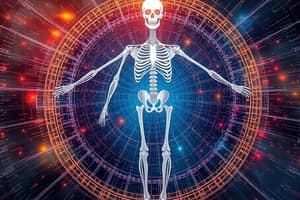Podcast
Questions and Answers
What is a lever?
What is a lever?
- A flexible object
- A type of balance scale
- A rigid object that rotates around a fixed point (correct)
- A type of machine that creates friction
What is the fixed point at which levers will rotate called?
What is the fixed point at which levers will rotate called?
Fulcrum
What is the force applied to one end of the lever to overcome the weight called?
What is the force applied to one end of the lever to overcome the weight called?
Force or effort
What is the weight of resistance at some point on the lever called?
What is the weight of resistance at some point on the lever called?
Which of the following describes the 1st class lever?
Which of the following describes the 1st class lever?
In which class of levers is the load positioned in the middle?
In which class of levers is the load positioned in the middle?
What is characteristic of a 3rd class lever?
What is characteristic of a 3rd class lever?
Flashcards are hidden until you start studying
Study Notes
Lever System Components
- Lever: A rigid structure that pivots around a fixed point; in the human body, bones function as levers to create movement.
- Fulcrum: The stable pivot point for the lever, typically represented by joints in anatomical movements.
- Force (Effort): The applied force necessary to move resistance, represented by muscles exerting force on the lever.
- Load (Resistance): The weight or resistance that needs to be moved by the lever, such as the weight of a body part.
Classes of Levers
- First Class Lever: The fulcrum is positioned between the effort and the load; this class allows for balanced movement and changes the direction of force.
- Second Class Lever: The load is situated between the fulcrum and the effort; this configuration maximizes force output and is efficient for lifting heavy loads.
- Third Class Lever: The effort is placed between the fulcrum and the load; this is the most common lever type in the human body, allowing for greater range of motion but requiring more effort for movement, such as in a bicep curl.
Lever Characteristics
- Each lever class has unique arrangements that affect mechanical advantage and movement efficiency.
- The design of levers in the human body allows for a combination of strength and speed in functional movements.
Studying That Suits You
Use AI to generate personalized quizzes and flashcards to suit your learning preferences.




